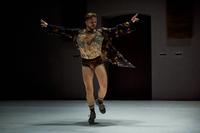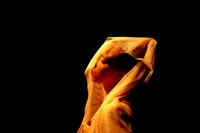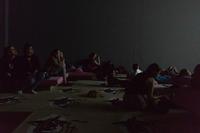NORMA
NORMA
NORMA is an international festival of theatre and contemporary art held in Ostrava. Norma is organised by PLATO Ostrava gallery and by Studio Hrdinů, a Prague-based theatre.
The NORMA festival presents original theatre projects dealing with trends and topics that have been of concern to the artists across generations and theatre genres. An important dimension of the festival is the close interconnection between theatre and visual arts, apparent in both particular theatre productions and visual art performances. This relationship is mutually beneficial: it is common for conceptual artists to reach beyond the range of the visual arts and thus theatre presents an exciting challenge for them; on the other hand, theatre-makers can find inspiration, transcend their field and discover an open-minded and fresh approach to their work.
Art Director
Jan Horák
jan.horak@studiohrdinu.cz
Press
Magdaléna Dušková
Communication
+420 727 815 134
magdalena.duskova@plato-ostrava.cz
Production team
Tereza Měsícová
Project manager
+420 737 856 981
tereza.mesicova@plato-ostrava.cz
Madla Zelenková
Production
+420 775 290 483
madla.zelenkova@studiohrdinu.cz
Due to the pandemics, restrictions related to it, and the re-evaluation of values all of which led to radical cuts in funds, the fifth edition of the NORMA festival has been reduced from its traditional two-day format to a one-day version. The subtitle of this year’s festival edition is “Autonomous Zone”. The festival focusses on projects creating an autonomous zone as a space of escapement but also as a sort of activism, perhaps somewhat autistic, yet perfectly transferable, i.e. not necessarily introverted. In some cases, these autonomous worlds are a playful refusal of our “reality”; in other cases they are more of an expression of a conscious resistance to it or an absolute immersion into one’s universe.
The playful performance The Deserted Island Protects 15,000 Inhabitants by stage designer and performer Zuzana Sceranková (a member of the progressive group “Eight Persons” and the youngest sister of well-known artists Pavla and Lucie Sceranková) and Natálie Rajnišová creates an autonomous world in which the lead role is acted by costumes – mythological beings-objects that keep appearing to mediate their micro universe – independent and not anchored in our reality – to us. Its form – a fashion show – perhaps aims at an easily understandable form but is actually inessential for the meaning of the performance.
Jumpcore, a performance by internationally renowned dancer and performer Paweł Sakowicz is a micro world seemingly minimalist in form and almost autistic in content that reminds of fantasy worlds. The project takes the viewer into such world by means of a rhythmical movement (incessant jumping going from peaceful to frenetic until near exhaustion) accompanied by spoken word. The result is a touching performance that engulfs the viewer. Jumpcore is the first dance project “owned” by the Zacheta Natinal Gallery in Warsaw, Poland.
Considering the shortened format of the festival and my need to embrace the issue of the autonomous world of an artist the best I could, I addressed curator Martin Mazanec and artist Dominik Gajdarský who often works with video, to create a series of videos by international artists who in their opinion discuss this subject in their works. Videos will be presented as a one-time screening, thus becoming an equal part of the festival’s dramaturgy.
The award-winning performance Pode ser by French dancer Leïla Ka is an immersion into the world of dance. Formally, the performance is an impressive solo combining Schubert and hip-hop music. In her performance, Leila is passionate, she fights and most importantly: she is enclosed and inaccessible in her own world. The performance has won numerous awards at festivals in Germany, Italy and Poland.
In line with NORMA’s tradition, the last performance is a work by a contemporary visual artist. This year, I addressed artist Marek Meduna, a former founding member of the Rafani group. For the “Autonomous Zone” Marek Meduna and his new group, Grottup, prepares a project on the borderline of a performance and rap concert.
Ideally, no festival should be viewed in fragments. The concept of NORMA can be experienced fully only when the viewer is willing to experience the festival in its totality.
Jan Horák
Art Director
PLATO
Janáčkova 22 (former Bauhaus store), Ostrava
map
Tram stop: Stodolní
Bus stop: Konzervatoř
Train stations: Ostrava-Stodolní, Ostrava hl.n.
Check timetables at www.dpo.cz. Public transport (MHD) tickets can be purchased via SMS (send DPO70 as a text of an SMS to the number 902 30) or with contactless bank card (“tap and ride”).
- Pass 450/250 CZK*
- Individual performances 150/90 CZK*
- Video 80/40 CZK*
* students, teachers, senior citizens and disabled people
Presale of festival passes will be available from August on GoOut and at the PLATO (Ostrava) and Studio Hrdinů (Prague) box offices.
Tickets for individual performances are available at the venue before each performance.
Accommodation
Low-cost accommodation
- Koleje Jana Opletala – Hladnov price from 400 CZK / night
- Hotel VP1 v areálu Dolní oblasti Vítkovic price from 750 CZK / night
Hotels
- Hotel Max price from 800 CZK / night
- Hotel Veronika price from 950 CZK / nightc
- Hotel Maria price from 1 200 CZK / night
- Hotel Imperial price from 1 500 CZK / night
- Other accommodations are listed on the Ostrava City Information Centre website.
Where to eat
We recommend the following restaurants and bars in the Ostrava city center. They are open on weekends:
- Boule za ušima (Mon–Sun), vege
-
La Petite Conversation (Mon–Sat up to 3 pm), vege
- Cafe Au Pere Tranquille (Mon–Sun), vege
- Ostrawina (Mon–Sat
- Divadelní klub NDM (Tue–Sun from 7 pm)
- Hospůdka u Kohlera (Mon–Sat)
- U Křižánka (Mon–Sun)
- Moravská chalupa (Mon–Sat)
- Los Capolitos (Mon–Sun), vege
-
Babetti (Wed–Sat)
-
Black Kale (Mon–Sat), vege, vegan
What to see
- Dolní oblast Vítkovice National cultural heritage
- The House of Art Significant Czech art museum; the building is from 1926
- New Town Hall Lookout Tower Built between 1925–1930; the lookout terrace is located at a height of 73 metres
- The Ema Heap 315 metres above sea level; clouds of smoke rise from the heap and the inner temperature reaches over 1000° C
- ‘Michal’ Coalmine in Ostrava National cultural heritage
- Discover more Ostrava Information Service
14←→



